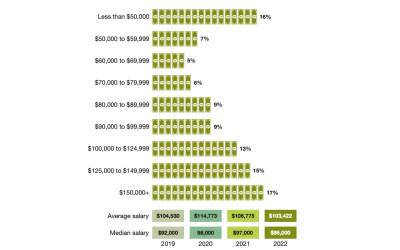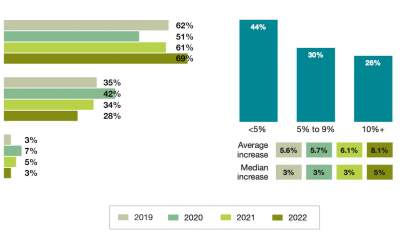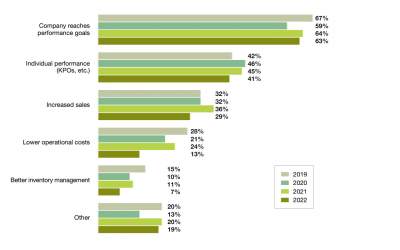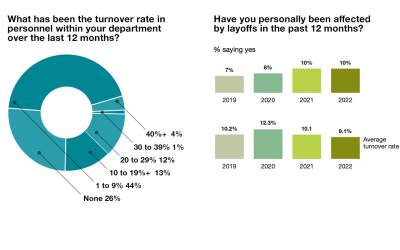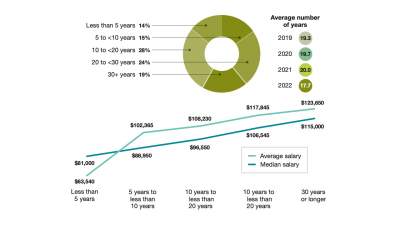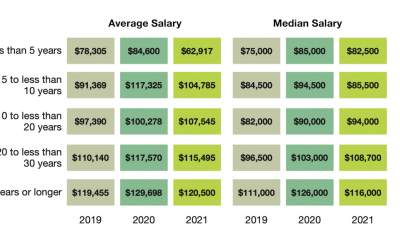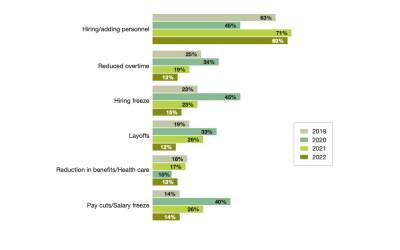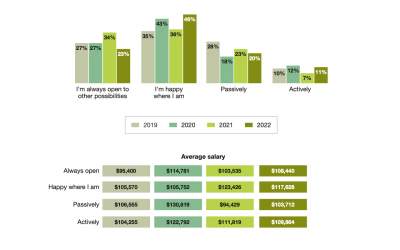Materials Handling Salary Survey 2022: Higher salaries, more bonuses & better working conditions
我们的年度薪酬调查探讨了补偿, job and career history, job responsibilities and career satisfaction for materials handling professionals.

The tight labor market, increased focus on supply chain efficiency and the uptick ine-commerceorder volumes have been pushing warehouse and DC operators to offer their materials handling professionals higher salaries, more bonuses and better working conditions. And while time spent at a company and educational levels both come into play here, the average salary increase reached a high of 8.1% this year (versus 6.1% in 2021 and 5.7% in 2020).
To best gauge current salaries and overall compensation for materials handling professionals,Peerless Research Groupwent directly to the source and surveyed Modern Materials Handling’s subscribers. Administered in August, the survey covered compensation, current job and overall career satisfaction, job responsibilities and demographic impacts on salary.
Most respondents work in manufacturing (47%) while others are employed by wholesale trade companies (14%), other non-manufacturing firms (12%), third-party logistics providers (11%), retail trade (9%) and transportation/warehousing services (7%). Here’s what we learned.
你目前的基本年薪202是什么2?
(not including bonuses and commissions)
Source: Peerless Research Group
Salary and compensation
This year, 17% of base salaries for materials handling professionals exceed $150,000, while 16% of respondents say they’re making less than $50,000. Average base salaries decreased slightly to $103,422 this year, from $106,775 in 2021 and $114,773 the prior year. Asked how their base salaries compare with last year, 69% of respondents are now making more money, 28% have stayed at the same level and 3% are making less. The average salary increase for 2021 was 8.1%, up from 6.1% last year.
The average bonus decreased slightly from $26,431 to $25,000 this year, but is still higher than prior years ($20,820 in 2019 and $24,592 in 2020). About 74% of respondents expect to receive a bonus, commission or additional form of income this year, while 26% don’t. The size of the bonuses vary, with 19% expecting $10,000 to $19,999 and 12% planning for somewhere between $1,000 to $2,999. About 10% of respondents are expecting bonuses of more than $50,000 this year.
Comparing their bonuses and commissions to 2021, 60% of respondents say the 2022 amounts are in line with what they received last year and 23% expect to receive more than they did in 2021.
Those bonuses are based on a number of different factors, including corporate performance goals (for 63% of respondents), individual performance (41%) and sales increases (29%). These results have remained fairly constant since 2019, with the exception of lower operational costs as a determiner of bonus levels. And 13% of respondents now say their bonuses are tied to this metric (versus 28% in 2019 and 21% in 2020).
Careers in materials handling
For the most part, the more time professionals spend in the materials handling industry, the higher their compensation and bonuses.
This is a trend that Peerless has been tracking since 2019, and it held true for 2022. Those professionals with between 10 and 30 years of experience report the highest salaries, ranging anywhere from $108,230 to $117,845 annually.
The average amount of time 2022’s survey respondents have spent in materials handling is about 18 years.
Knowing that professionals have job options in today’s market, the survey also looked at the number of companies that respondents have worked for during their careers. An even number (23% each) have worked either for just one company
or three total companies.
那些只有一个雇主平均9美元6,700 in salary for 2022, while those that have worked for two other companies (their current employer plus two others) made $109,970. The highest salary level ($129,700) was reported by respondents who worked for four other companies during their careers (or five companies total).
Twenty-seven percent of respondents have worked for their present employer for 10 to 20 years, and 25% have been in place for 5 to 10 years. Overall, the average number of years at a current employer is just more than 10. About 67% of these professionals have supervisory responsibilities and 58% have budgetary responsibilities. Those with supervisory responsibilities reported an average salary of $112,745 (down from $116,661 last year) and professionals that manage budgets earn $116,587 (the same as 2021).
Managing employee turnover and layoffs
Most respondents (69%) have hired or added personnel over the last 12 months, down from 71% in 2021 but significantly higher than the 45% of professionals who were hiring in 2020. Anywhere from 12% to 15% of professionals say their companies enacted hiring freezes, reduced overtime, laid employees off, reduced benefits and/or froze salaries this year.
Asked about the turnover rates within their departments, 44% of professionals reported rates in the 1% to 9% range while 26% haven’t seen any turnover. The average turnover rate was 9.1% in 2022.
Additionally, 10% of respondents say they have been personally affected by layoffs during the last 12 months. This percentage matches what we saw in 2021, but is higher than the 8% and 7% turnover rates reported in 2020 and 2019, respectively.
Measuring job satisfaction
Nearly all of this year’s survey respondents (91%) say they would recommend the materials handling profession to others. This high recommendation rate has remained constant over the last three years.
In terms of job satisfaction, 46% of professionals say they are “very” satisfied, 32% are “somewhat” satisfied, and 19% are “extremely” satisfied with their career. And 4% of respondents are either “not very” satisfied or “not at all” satisfied in their current positions.
Ninety percent of respondents indicate they like their current jobs and 46% say they’re happy where they are currently. Another 23% are always open to other possibilities, 20% are passively looking for another job and 11% are actively looking for new opportunities.
Professionals who are happy with their current employers report the highest average salary of $117,628, while those actively looking report an average salary of $109,864. The professionals that are open to new opportunities report an average salary of $108,440, and those passively looking earn an average of $103,712 annually.
The job seekers in the survey sample are in search of higher compensation (73%), better advancement opportunities (45%), new challenges (39%) and a different manager or management (27%).
Thirty-four percent of respondents say their jobs are either extremely or very stressful, while 49% find the career somewhat stressful. The main factors contributing to job stress include workload (48%), balancing work and home life (40%), questionable management decisions (32%), and working with outdated technology (32%).
Other stressors include a lack of enough people to get the job done, not enough time to get the work done and poor career development opportunities. Those who consider their jobs to be extremely stressful earn the highest average salary at $102,980, followed by those who say their job is not very or at all stressful, with an average of $100,540.
Survey demographics and impacts on salary
Thirty-five percent of this year’s survey participants completed technical school, while 24% have completed some college, 11% hold an MBA degree, and 10% have completed high school. Nine percent hold a two-year degree, 7% hold an undergraduate four-year college degree, and 3% hold another graduate degree.
The highest earners in the bunch hold MBAs and reported an average salary of $136,087, followed by those with another graduate degree with an average of $126,500. The average age of respondents is 51, with 33% being between 55 and 64, 30% between 45 and 54, and 16% between 35 and 44. Eleven percent are between 18 and 34, and 10% are over the age of 65.
The 45-to-54 age group earns the most with an average salary of $121,530, followed by those 55 to 64, with an average salary of $115,135, and professionals over 65, who earn $114,325 on average. Those aged 35 to 44 earn an average of $108,100, and anyone under 35 years old earns the lowest average salary of $79,400. The majority of respondents (86%) were male and 14% were female. Men reported an average annual salary of $113,688, and women reported an average of $102,795.
Specific job roles and titles also play a role in compensation levels. According to the survey, the highest earners (at an average of $146,910) hold titles like CEO, president, vice president and general manager, followed by engineering professionals, who earn an average of $112,100. Plant managers earn an average of $96,200 annually, followed by warehouse/distribution/logistics professionals at $97,100 and purchasing professionals at $98,820.
Companies with more than 1,000 employees pay out the highest average salaries to their professionals, who earn anywhere from $116,670 (for those with 5,000+ associates) to $117,060 (for those with 1,000 to 4,999 employees). Respondents reporting the lowest average salaries of $86,853 work for companies with fewer than 100 employees. This hierarchy has remained fairly constant over the last three years.
The survey also explored the connection between geographic location and salary, and found that professionals in the Mid-Atlantic and Southeast regions of the United States tend to earn the highest salaries, at $112,255 and $112,650, respectively. Materials handling professionals across the rest of the nation earn anywhere from $93,220 (in the South) to $110,500 (in the Midwest).

Article Topics
Labor Management News & Resources
32nd Annual Study of Logistics and Transportation Trends: Navigating a shallow pool of resources Logistics Labor: Increasing retention Trinet管理服务:Streamlining Logistics Operations for Enhanced Efficiency A Dedicated Uniform Program Can Help Drive Your Company’s Success Association of American Railroads makes its case for rail labor deals to be ratified 31st Annual Study of Logistics and Transportation Trends: Meeting the need for talent What Workplaces Aren’t Getting from Hourly Staffing Providers More Labor Management最新物流
C.H. Robinson announces opening of new Port of Laredo cross-border facility Navigating the Panama Canal drought: ways to get your shipments Moving Port Tracker points to U.S.-bound import gains in the coming months UPS introduces 2024 rate increases National Retail Federation acquires Reverse Logistics Association U.S. rail carload and intermodal volumes see August declines, reports AAR STB introduces new service-focused reciprocal switching NPRM More LogisticsAbout the Author
Subscribe to Logistics Management Magazine

Find out what the world's most innovative companies are doing to improve productivity in their plants and distribution centers.
Start your FREE subscription today.
September 2023
万博2.0app下载

Latest Resources


